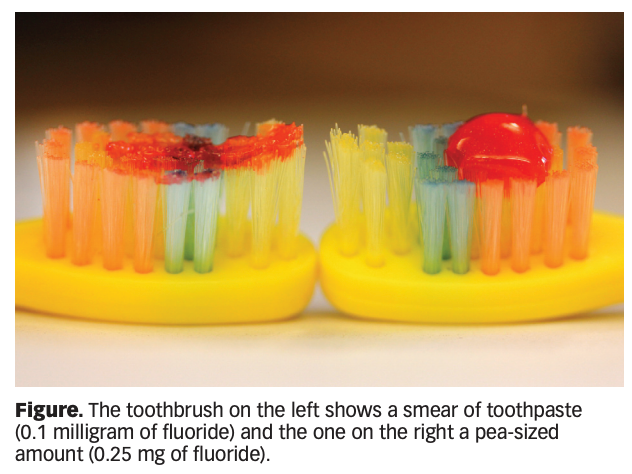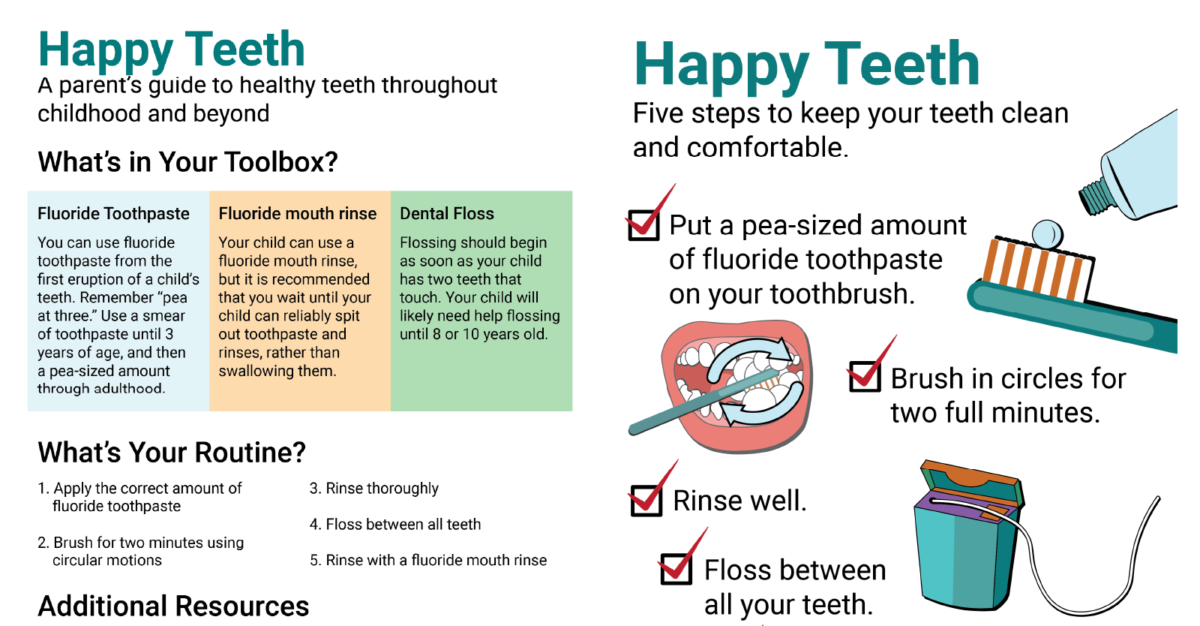A newborn’s growing teeth are crucial to their overall development as a child. Baby teeth are the foundation for a strong set of adult teeth because they act as placeholders for permanent teeth. Poor oral health when your child is young can often result in crooked teeth and more serious oral health complications.
For more on why baby teeth matter and how to protect them, visit this American Dental Association resource.
So, when should I start brushing my child’s teeth?
It is safe to clean your baby’s mouth shortly after birth. Using a clean, moist washcloth, wrapped around one finger, carefully massage the gums. This can be done after every feeding until their teeth start to appear at around six months.
After the first teeth start to appear, brushing with a soft bristled toothbrush can significantly reduce the risk of tooth decay. Be sure to regularly check inside your child’s mouth and under their lips for white or brown spots that may be indicative of cavities.

Brush with a small amount of fluoride toothpaste (about the size of a grain of rice) until your child is three years old. After the age of three, a pea-sized amount of fluoride toothpaste can be used to brush their teeth. By this age most children will have all 20 primary teeth. Begin teaching them to spit to avoid swallowing the toothpaste.
Allowing your child to pick their own toothbrush and toothpaste can encourage regular brushing. Just be sure to check for the American Dental Association (ADA) seal of approval.
A consistent routine is the single most important thing you can do to ensure your child has a healthy mouth; but how teeth are brushed can also make an impact. Try to use small, circular motions as well as you can — it can be tough, especially when you begin teaching your child to brush their own teeth.
Brushing should be supervised twice a day until the age of six, when children are typically able to do it alone. Clean the inner, outer, and chewing surfaces for a total of at least two minutes every time.
Click the image to download a printable version or to see an additional guide for parents
What is teething?
Did you know babies are already born with all their tooth buds?
Teething is when your baby’s teeth begin to push through the gums. This typically occurs between months four and seven. However, it is important to remember every child is different and for some, this can even occur at 12 months. Slower rates of growth are not necessarily a means for concern.
The two bottom front teeth are often the first to appear, followed by the four top front teeth. The last to erupt are generally the molars and eyeteeth, which are located in the upper jaw.
For some children, teething can be a frustrating process that may cause irritability. For others, it may appear painless. You will likely notice more frequent drooling and the desire to chew on different objects. This is perfectly normal and is a form of coping with the new feeling.
To relieve some of the symptoms of discomfort, give your baby safe toys such as a rubber teething ring with no liquid inside. A wet washcloth that has been frozen for about 15 minutes may also be helpful. Continually clean around your baby’s mouth to prevent rashes if there is excessive drooling.
When should I take my child to the dentist?
It is possible for cavities to appear in the mouth as soon as the first teeth erupt. Therefore, it is important to be proactive with oral care. One of the best ways to do this is to schedule a dentist appointment.
According to the American Dental Association, a child’s first dental exam should be scheduled no later than the first birthday or after the first tooth erupts, typically around month six. The American Academy of Pediatric Dentistry also recommends regular visits every six months after this.
During these visits, the dentist will clean the teeth and can apply a fluoride solution to fight cavities. They will also check on teeth development and give advice on how to maintain proper hygiene.
For more information about early childhood preventive solutions like fluoride varnish and dental sealants, click here to see last week’s blog post.
The American Academy of Pediatrics has also developed a schedule of well-child visits to reinforce the overall well-being of developing children. This entails a recommended visit within the first week of birth, and then once a month for the first two months. After that, the child should be seen once every two months until the child is 18 months old. It is recommended the child be seen twice a year at age two, and then once a year until they are 21 years old.
If you notice anything concerning about your child’s teeth, or hear your child complain about pain, you should also make an appointment with the dentist.
For more information about well-child visit schedules, click here.
Caring for your child’s teeth at home
A healthy diet is important for a developing child and can have a direct impact on their teeth. Too much sugar can eat away at the enamel that covers the outer layer of the teeth, leaving them more vulnerable to plaque and bacteria.
Try to limit your child’s sugar consumption to avoid the risk of tooth decay and other health complications.
If you do not have access to fluoridated tap water at home, using a fluoride toothpaste is especially important. Fluoride is safe for young children and is one of the most effective forms of preventive care. The dentist may also prescribe chewable tablets or fluoride drops for your child if necessary; another great reason to schedule regular dental appointments!
NCOHC is a program of the Foundation for Health Leadership & Innovation. For more information and to stay up to date, subscribe to the NCOHC newsletter. If you are interested in becoming an NCOHC member, you can also fill out our membership form. It’s free!



